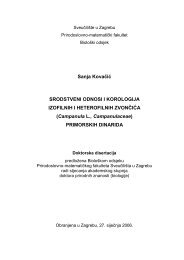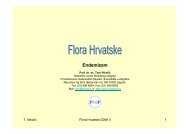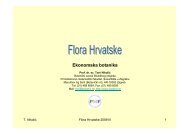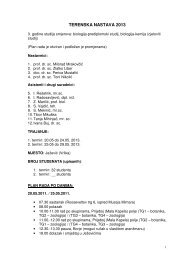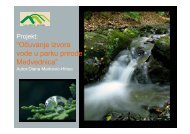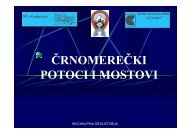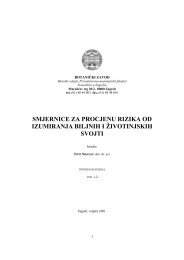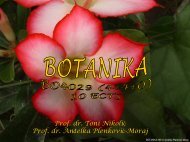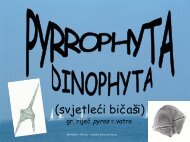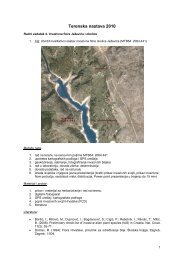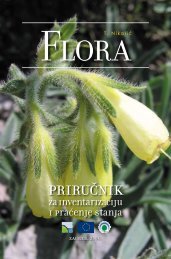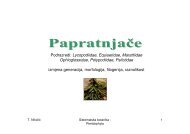important plant areas in central and eastern europe - hirc.botanic.hr ...
important plant areas in central and eastern europe - hirc.botanic.hr ...
important plant areas in central and eastern europe - hirc.botanic.hr ...
Create successful ePaper yourself
Turn your PDF publications into a flip-book with our unique Google optimized e-Paper software.
Section 2MethodologyDef<strong>in</strong>ition <strong>and</strong> general pr<strong>in</strong>ciplesAn IPA is a natural or semi-natural site exhibit<strong>in</strong>g exceptional <strong>botanic</strong>al richness <strong>and</strong>/orsupport<strong>in</strong>g an outst<strong>and</strong><strong>in</strong>g assemblage of rare, t<strong>hr</strong>eatened <strong>and</strong>/or endemic <strong>plant</strong> species<strong>and</strong>/or vegetation of high <strong>botanic</strong> value.Criterion A:Criterion B:Criterion C:T<strong>hr</strong>eatened SpeciesBotanical RichnessT<strong>hr</strong>eatened HabitatsIPA Criteria were developed <strong>and</strong> ref<strong>in</strong>ed t<strong>hr</strong>ough extensive consultation over severalyears <strong>and</strong> references are given at the end of this section.The IPA Site Selection Manual forEurope gives more detail on identify<strong>in</strong>g sites.Criteria sources, categories <strong>and</strong> t<strong>hr</strong>esholds for Europe used <strong>in</strong> this project are presented<strong>in</strong> the table below.Criterion A: t<strong>hr</strong>eatened speciesFor the seven partner countries 518 taxa were <strong>in</strong>cluded <strong>in</strong> the Criterion A list oft<strong>hr</strong>eatened species. 403 of those were vascular <strong>plant</strong>s, 54 were bryophytes, 34 werelichens, <strong>and</strong> 27 were fungi.Ai Global T<strong>hr</strong>eat 42 taxaAi/Aii Global & European T<strong>hr</strong>eat 32 taxaAii European (Regional T<strong>hr</strong>eat) 196 taxaAiii National Endemic (T<strong>hr</strong>eatened) 109 taxaAiv Near Endemic/Limited Range (T<strong>hr</strong>eatened) 137 taxaAccepted Sources for EuropeFor Ai, global t<strong>hr</strong>eat, the follow<strong>in</strong>g sources were used: the IUCN Global Red List 1997<strong>and</strong> 2002; the World List of T<strong>hr</strong>eatened Trees 1998; the Global Red List for Bryophytes2001. For Aii, European T<strong>hr</strong>eat, the follow<strong>in</strong>g sources were used: the EU HabitatsDirective Annexes IIb <strong>and</strong> IVb; the Bern Convention Appendix 1; the European Red Listof Bryophytes 1995; the European Red List of Macro-lichens 1989. The 33 t<strong>hr</strong>eatenedfungi species prepared by the European Committee for the Conservation of Fungi(ECCF) were also used <strong>in</strong> this project under Aii. National red lists were used forassess<strong>in</strong>g the t<strong>hr</strong>eat status of Aiii, national endemics, <strong>and</strong> Aiv, near endemic/limited rangespecies.One of the ma<strong>in</strong> challenges for this criterion is to identify priority t<strong>hr</strong>eatened specieswhich are not endemic or limited range, but are relatively widespread geographically <strong>and</strong>decl<strong>in</strong><strong>in</strong>g everywhere.A new IUCN European Red List would help to identify thesetypes of species. National IUCN Red Lists <strong>in</strong> those countries which do not currentlyhave them, <strong>and</strong> European Red Lists for lichens, fungi <strong>and</strong> algae would also help toprioritise conservation target species.16



